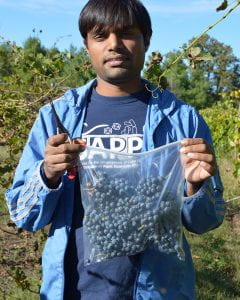Construction of a high-density linkage map and QTL detection of downy mildew resistance in Vitis aestivalis-derived ‘Norton’
Authors: Surya Sapkota, Li-Ling Chen, Shanshan Yang, Katie E. Hyma, Lance Cadle-Davidson and Chin-Feng Hwang
Theoretical and Applied Genetics, 132, pages 137-147. DOI: 10.1007/s00122-018-3203-6.
Summary by Janet Van Zoeren
The Takeaway.

These Vitis aestivalis-derived Norton grapes can provide downy mildew resistance genes to their offspring.
- A high-resolution genetic map of the Vitis aestivalis-derived cultivar ‘Norton’ was developed by combining two types of genetic markers: Single nucleotide polymorphisms (SNP) and Simple sequence repeats (SSR).
- A genetic locus was found that contributes 34% of the phenotypic variance in Norton-derived grapevines’ resistance to downy mildew.
- This locus was derived from ‘Norton’ parentage, and was previously undescribed. It is now designated as “Rpv27”.
Background. Grapevine downy mildew (DM), caused by a fungus-like oomycete, is a damaging disease in Vitis vinifera grape production areas. Many North American species of Vitis are resistant to DM, and previous studies have found a total of 26 genetic regions associated with DM resistance (see RIPE summary of Divilov et al 2018). With the help of DNA markers that are associated with these regions, grape breeders are able to select which plants are resistant to downy mildew at the seedling stage and to more efficiently breed new cultivars.
Most of the previous DM resistance regions were determined using “SSR” genetic mapping, which can be compared to knowing broadly where to find someone’s house, but not the exact street or house number. Those “low resolution” maps provide imprecise information about which seedlings a breeder should keep. By combining both the previous SSR mapping technology with VitisGen1-generated GBS-based SNPs, Sapkota et al. made a high-resolution genetic linkage map of ‘Norton’ x ‘Cabernet Sauvignon’ hybrid grapevines to use in the search for a new genetic region associated with resistance to DM in ‘Norton’-derived grapevines.

A grape leaf close-up, showing early symptoms of downy mildew susceptibility.
Experiment. In order to link genetic regions with the various phenotypes, including DM resistance, a “mapping population” was created by crossing ‘Norton’ (V. aestivalis, resistant) with ‘Cabernet Sauvignon’ (V. vinifera, susceptible). 182 hybrid F1 progeny were planted at the Fruit Experiment Station of Missouri State University at Mountain Grove, and DNA from these vines, plus the two parents, was used for both the SSR and SNP analyses.
DM susceptibility of each of the hybrids and parents was evaluated both in the field and in the laboratory. In the lab, leaves were inoculated with DM spores, then infection was visually scored on a scale of 1-5 and verified microscopically. In the field, visual assessments were conducted three times through the season, and were also scored on a scale of 1-5. Each assessment was conducted independently by two researchers, and the scores were averaged.
The results of the genetic mapping and phenotyping studies were combined using a QTL (quantitative trait loci) mapping software that determines which differences in the DNA code are most strongly associated with differences in grapevine DM susceptibility.
Results. Over forty thousand genetic markers were identified. Comparing the genetic information from the 184 grapevines, 4,236 locations were found where the genetic information was consistently present, but differed between individuals. Out of these, 2,072 markers were mapped, and found to be distributed across all of the grape’s chromosomes. Genetic markers represent regions that, if associated with important phenotypic traits such as DM resistance, provide information to breeders allowing them to use “marker-assisted selection” (MAS), a time- and resource-efficient method to breed improved grape cultivars.
One genetic region for DM resistance was found. Combining the 4,236 genetic markers with the DM phenotyping data, a single genetic region was found to consistently be associated with DM resistance. This region was previously undescribed, and the authors designated it as Rpv27.
Conclusions and practical considerations. Using both SNP and SSR marking strategies on a ‘Norton’ x ‘Cabernet Sauvignon’ mapping population, the authors were able to locate a previously-unidentified locus associated with DM resistance in ‘Norton’ lineages. This discovery will provide another tool for grape breeders, who are looking for ways to include DM resistance in new grape cultivars, especially as they look to include multiple resistance genes to confer added durability to the resistance.
